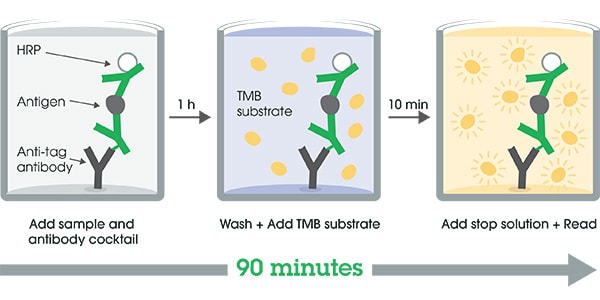Human HNF-4-alpha ELISA Kit (ab210581)
Key features and details
- One-wash 90 minute protocol
- Sensitivity: 3.3 pg/ml
- Range: 31 pg/ml - 2000 pg/ml
- Sample type: Cell culture extracts
- Detection method: Colorimetric
- Assay type: Sandwich (quantitative)
- Reacts with: Human
Overview
-
Product name
Human HNF-4-alpha ELISA Kit
See all HNF-4-alpha kits -
Detection method
Colorimetric -
Precision
Intra-assay Sample n Mean SD CV% Cell extract 5 4.9% Inter-assay Sample n Mean SD CV% Cell extract 3 8.5% -
Sample type
Cell culture extracts -
Assay type
Sandwich (quantitative) -
Sensitivity
3.3 pg/ml -
Range
31 pg/ml - 2000 pg/ml -
Recovery
Sample specific recovery Sample type Average % Range Cell culture extracts 103 101% - 107% -
Assay time
1h 30m -
Assay duration
One step assay -
Species reactivity
Reacts with: Human -
Product overview
Human HNF-4-alpha ELISA Kit (ab210581) is a single-wash 90 min sandwich ELISA designed for the quantitative measurement of HNF-4-alpha protein in cell culture extracts. It uses our proprietary SimpleStep ELISA® technology. Quantitate Human HNF-4-alpha with 3.3 pg/ml sensitivity.
SimpleStep ELISA® technology employs capture antibodies conjugated to an affinity tag that is recognized by the monoclonal antibody used to coat our SimpleStep ELISA® plates. This approach to sandwich ELISA allows the formation of the antibody-analyte sandwich complex in a single step, significantly reducing assay time. See the SimpleStep ELISA® protocol summary in the image section for further details. Our SimpleStep ELISA® technology provides several benefits:
- Single-wash protocol reduces assay time to 90 minutes or less
- High sensitivity, specificity and reproducibility from superior antibodies
- Fully validated in biological samples
- 96-wells plate breakable into 12 x 8 wells stripsA 384-well SimpleStep ELISA® microplate (ab203359) is available to use as an alternative to the 96-well microplate provided with SimpleStep ELISA® kits.
-
Notes
Hepatocyte nuclear factor 4 alpha (HNF4-alpha) is a transcription factor involved in the transcription of genes essential for development of the liver, kidney and intestine.
Abcam has not and does not intend to apply for the REACH Authorisation of customers’ uses of products that contain European Authorisation list (Annex XIV) substances.
It is the responsibility of our customers to check the necessity of application of REACH Authorisation, and any other relevant authorisations, for their intended uses. -
Platform
Microplate (12 x 8 well strips)
Properties
-
Storage instructions
Store at +4°C. Please refer to protocols. -
Components 1 x 96 tests 10X Human HNF4a Capture Antibody 1 x 600µl 10X Human HNF4a Detector Antibody 1 x 600µl 10X Wash Buffer PT (ab206977) 1 x 20ml 50X Cell Extraction Enhancer Solution (ab193971) 1 x 1ml 5X Cell Extraction Buffer PTR (ab193970) 1 x 10ml Antibody Diluent 5BI 1 x 6ml Human HNF4a Lyophilized Recombinant Protein 2 vials Plate Seals 1 unit Sample Diluent NS (ab193972) 1 x 12ml SimpleStep Pre-Coated 96-Well Microplate (ab206978) 1 unit Stop Solution 1 x 12ml TMB Development Solution 1 x 12ml -
Research areas
- Epigenetics and Nuclear Signaling
- Transcription
- Polymerase associated factors
- Pol II Transcription
- Other
- Metabolism
- Pathways and Processes
- Metabolic signaling pathways
- Lipid and lipoprotein metabolism
- Lipid metabolism
- Metabolism
- Pathways and Processes
- Metabolic signaling pathways
- Lipid and lipoprotein metabolism
- Cholesterol Metabolism
- Metabolism
- Pathways and Processes
- Metabolic signaling pathways
- Lipid and lipoprotein metabolism
- Lipases
-
Function
Transcriptionally controlled transcription factor. Binds to DNA sites required for the transcription of alpha 1-antitrypsin, apolipoprotein CIII, transthyretin genes and HNF1-alpha. May be essential for development of the liver, kidney and intestine. -
Involvement in disease
Defects in HNF4A are the cause of maturity-onset diabetes of the young type 1 (MODY1) [MIM:125850]; also symbolized MODY-1. MODY is a form of diabetes that is characterized by an autosomal dominant mode of inheritance, onset in childhood or early adulthood (usually before 25 years of age), a primary defect in insulin secretion and frequent insulin-independence at the beginning of the disease. -
Sequence similarities
Belongs to the nuclear hormone receptor family. NR2 subfamily.
Contains 1 nuclear receptor DNA-binding domain. -
Post-translational
modificationsPhosphorylated on tyrosine residue(s); phosphorylation is important for its DNA-binding activity. Phosphorylation may directly or indirectly play a regulatory role in the subnuclear distribution. -
Cellular localization
Nucleus. - Information by UniProt
-
Alternative names
- FLJ39654
- FRTS4
- Hepatic nuclear factor 4 alpha
see all -
Database links
- Entrez Gene: 3172 Human
- Omim: 600281 Human
- SwissProt: P41235 Human
- Unigene: 116462 Human
Images
-
SimpleStep ELISA technology allows the formation of the antibody-antigen complex in one single step, reducing assay time to 90 minutes. Add samples or standards and antibody mix to wells all at once, incubate, wash, and add your final substrate. See protocol for a detailed step-by-step guide.
-
Background-subtracted data values (mean +/- SD) are graphed.
-
 Interpolated concentrations of native HNF4-alpha in human HepG2 extract and based on a 40 µg/mL extract load.
Interpolated concentrations of native HNF4-alpha in human HepG2 extract and based on a 40 µg/mL extract load.The concentrations of HNF4a were measured in duplicate and interpolated from the HNF4-alpha standard curve and corrected for sample dilution. The interpolated dilution factor corrected values are plotted (mean +/- SD, n=2). The mean HNF4-alpha concentration was determined to be 1346 µg/mL in HepG2 extract.
-
To learn more about the advantages of recombinant antibodies see here.










